Demonstrating Knowledge of Management Theories in Organizations
VerifiedAdded on 2023/05/28
|48
|12122
|300
Essay
AI Summary
This essay examines various aspects of management within organizations. It begins by defining management and exploring different management theories, including classical, behavioral, and modern approaches, along with their strengths and weaknesses. The essay then delves into organizational structure, power dynamics, and integration strategies. Furthermore, it analyzes motivation, comparing content and process theories such as Maslow's hierarchy and ERG theory, and discusses different managerial approaches and job design options. The essay also covers leadership, differentiating between leadership and management roles, comparing leadership styles, and analyzing their strengths and weaknesses. The essay concludes by comparing leadership and management and highlighting the changes in current organizations.
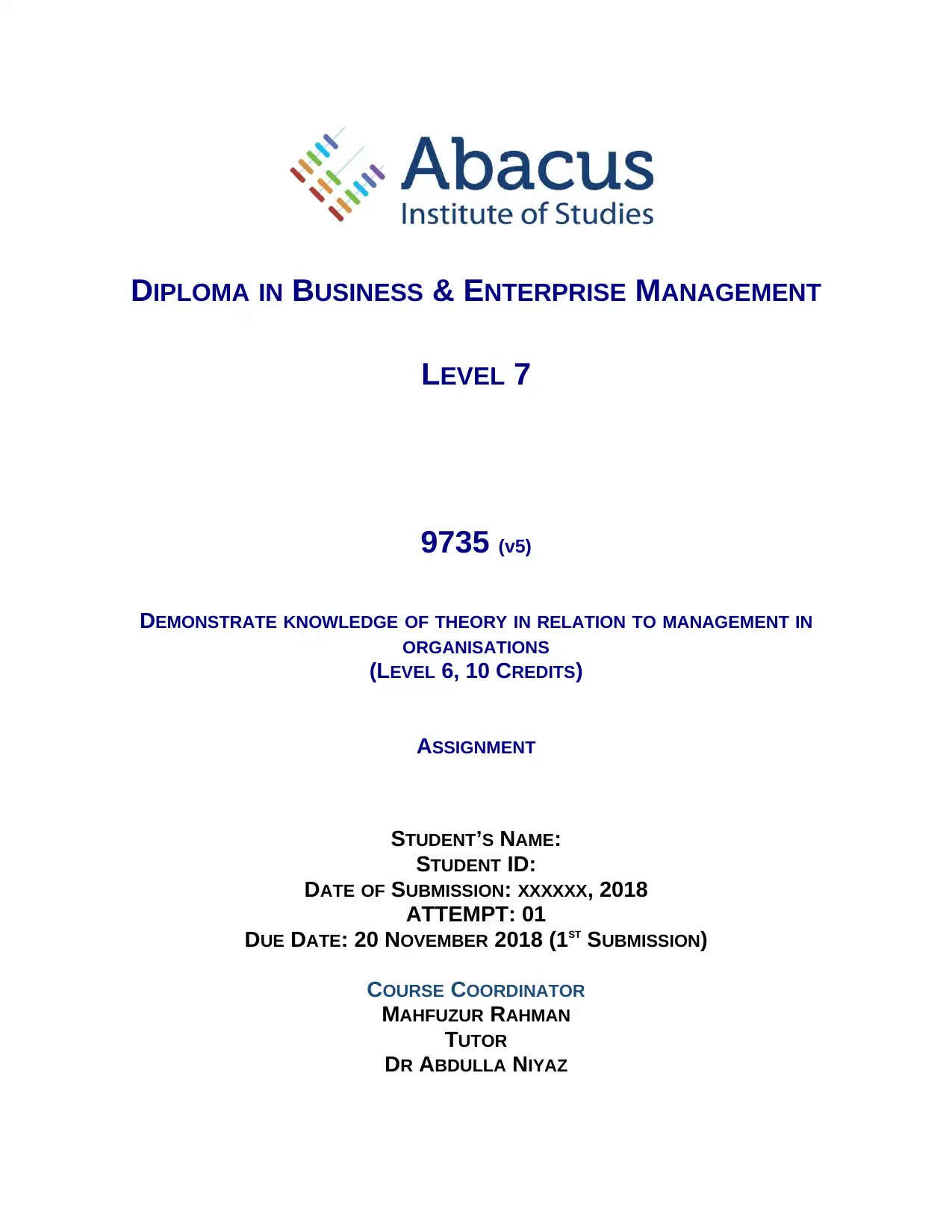
DIPLOMA IN BUSINESS & ENTERPRISE MANAGEMENT
LEVEL 7
9735 (v5)
DEMONSTRATE KNOWLEDGE OF THEORY IN RELATION TO MANAGEMENT IN
ORGANISATIONS
(LEVEL 6, 10 CREDITS)
ASSIGNMENT
STUDENT’S NAME:
STUDENT ID:
DATE OF SUBMISSION: XXXXXX, 2018
ATTEMPT: 01
DUE DATE: 20 NOVEMBER 2018 (1ST SUBMISSION)
COURSE COORDINATOR
MAHFUZUR RAHMAN
TUTOR
DR ABDULLA NIYAZ
LEVEL 7
9735 (v5)
DEMONSTRATE KNOWLEDGE OF THEORY IN RELATION TO MANAGEMENT IN
ORGANISATIONS
(LEVEL 6, 10 CREDITS)
ASSIGNMENT
STUDENT’S NAME:
STUDENT ID:
DATE OF SUBMISSION: XXXXXX, 2018
ATTEMPT: 01
DUE DATE: 20 NOVEMBER 2018 (1ST SUBMISSION)
COURSE COORDINATOR
MAHFUZUR RAHMAN
TUTOR
DR ABDULLA NIYAZ
Paraphrase This Document
Need a fresh take? Get an instant paraphrase of this document with our AI Paraphraser
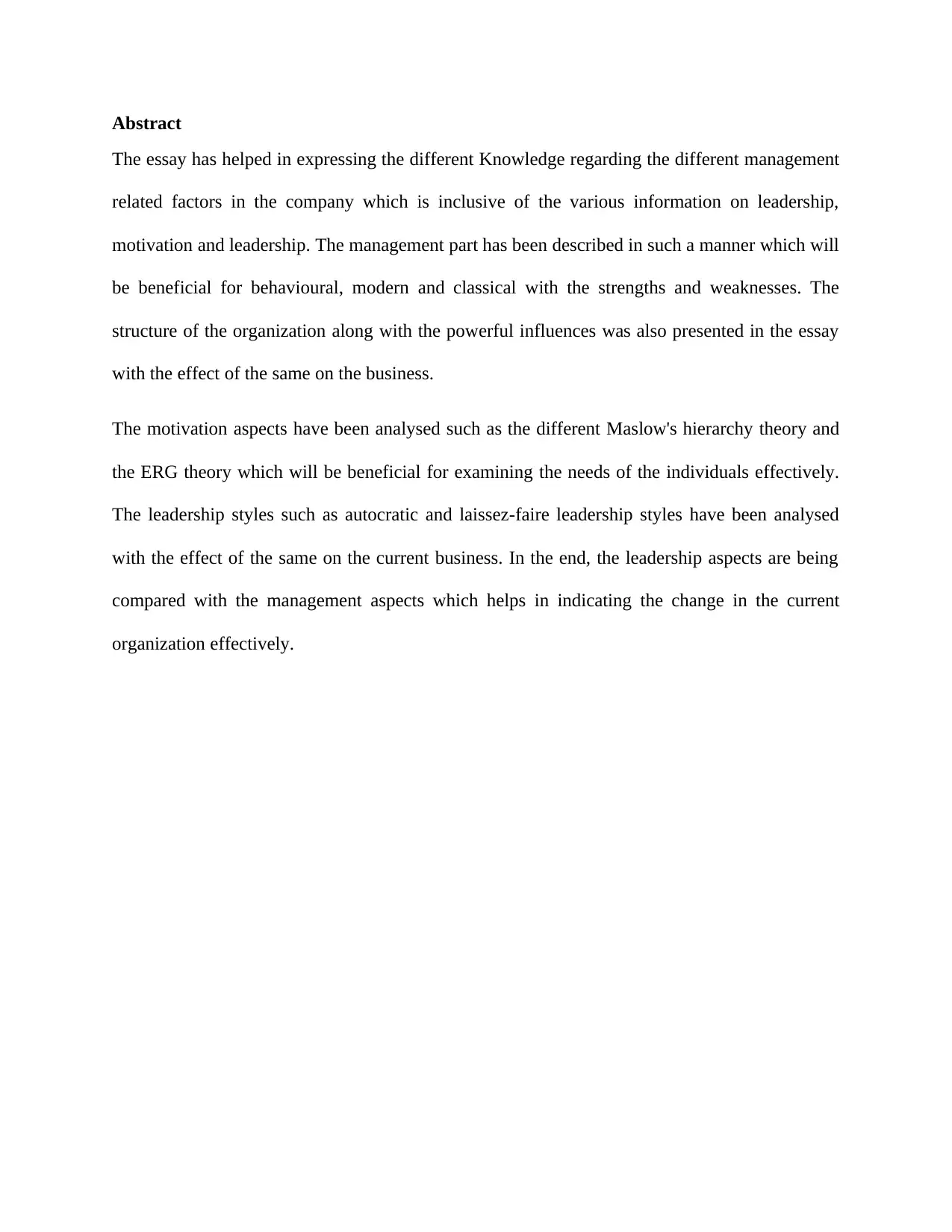
Abstract
The essay has helped in expressing the different Knowledge regarding the different management
related factors in the company which is inclusive of the various information on leadership,
motivation and leadership. The management part has been described in such a manner which will
be beneficial for behavioural, modern and classical with the strengths and weaknesses. The
structure of the organization along with the powerful influences was also presented in the essay
with the effect of the same on the business.
The motivation aspects have been analysed such as the different Maslow's hierarchy theory and
the ERG theory which will be beneficial for examining the needs of the individuals effectively.
The leadership styles such as autocratic and laissez-faire leadership styles have been analysed
with the effect of the same on the current business. In the end, the leadership aspects are being
compared with the management aspects which helps in indicating the change in the current
organization effectively.
The essay has helped in expressing the different Knowledge regarding the different management
related factors in the company which is inclusive of the various information on leadership,
motivation and leadership. The management part has been described in such a manner which will
be beneficial for behavioural, modern and classical with the strengths and weaknesses. The
structure of the organization along with the powerful influences was also presented in the essay
with the effect of the same on the business.
The motivation aspects have been analysed such as the different Maslow's hierarchy theory and
the ERG theory which will be beneficial for examining the needs of the individuals effectively.
The leadership styles such as autocratic and laissez-faire leadership styles have been analysed
with the effect of the same on the current business. In the end, the leadership aspects are being
compared with the management aspects which helps in indicating the change in the current
organization effectively.
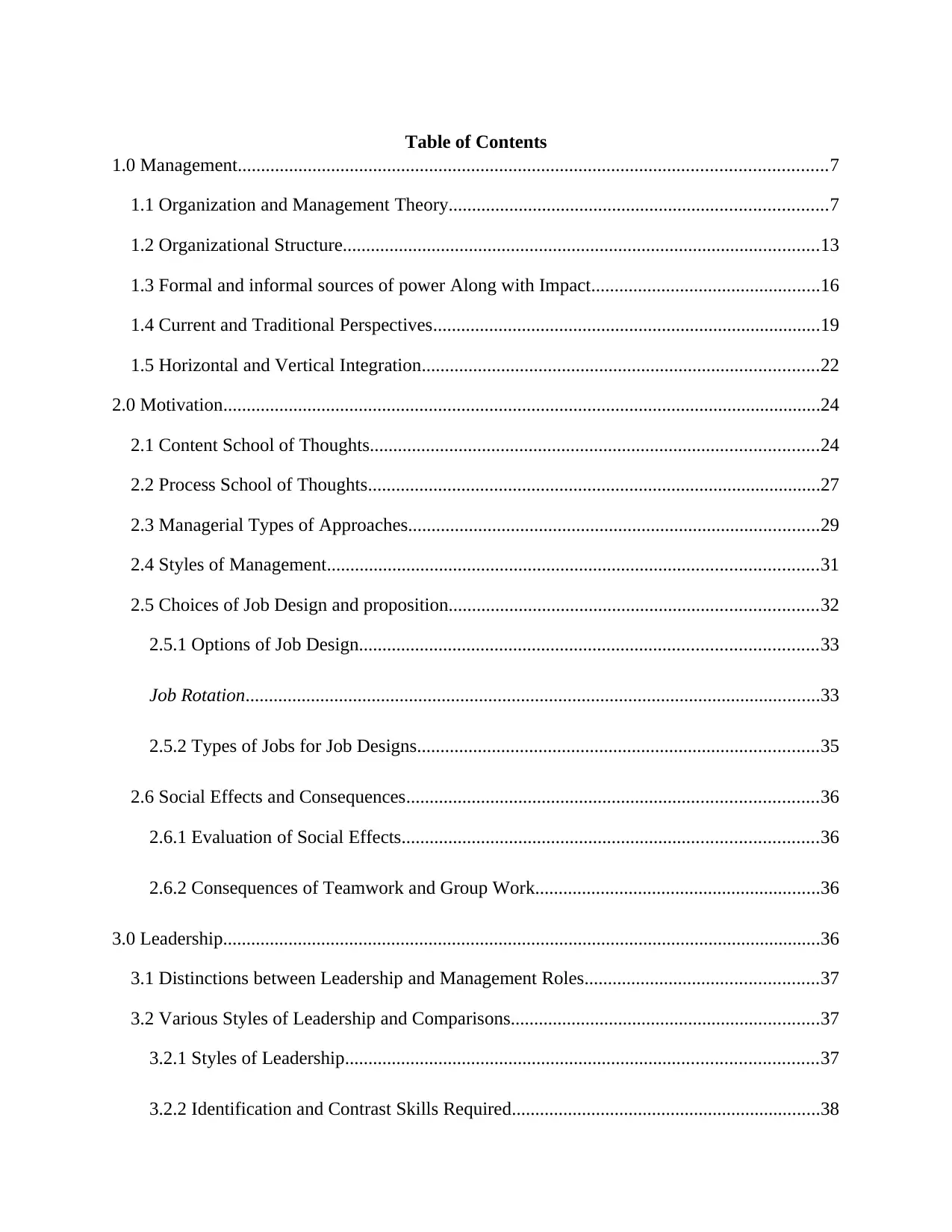
Table of Contents
1.0 Management..............................................................................................................................7
1.1 Organization and Management Theory.................................................................................7
1.2 Organizational Structure......................................................................................................13
1.3 Formal and informal sources of power Along with Impact.................................................16
1.4 Current and Traditional Perspectives...................................................................................19
1.5 Horizontal and Vertical Integration.....................................................................................22
2.0 Motivation................................................................................................................................24
2.1 Content School of Thoughts................................................................................................24
2.2 Process School of Thoughts.................................................................................................27
2.3 Managerial Types of Approaches........................................................................................29
2.4 Styles of Management.........................................................................................................31
2.5 Choices of Job Design and proposition...............................................................................32
2.5.1 Options of Job Design..................................................................................................33
Job Rotation...........................................................................................................................33
2.5.2 Types of Jobs for Job Designs......................................................................................35
2.6 Social Effects and Consequences........................................................................................36
2.6.1 Evaluation of Social Effects.........................................................................................36
2.6.2 Consequences of Teamwork and Group Work.............................................................36
3.0 Leadership................................................................................................................................36
3.1 Distinctions between Leadership and Management Roles..................................................37
3.2 Various Styles of Leadership and Comparisons..................................................................37
3.2.1 Styles of Leadership.....................................................................................................37
3.2.2 Identification and Contrast Skills Required..................................................................38
1.0 Management..............................................................................................................................7
1.1 Organization and Management Theory.................................................................................7
1.2 Organizational Structure......................................................................................................13
1.3 Formal and informal sources of power Along with Impact.................................................16
1.4 Current and Traditional Perspectives...................................................................................19
1.5 Horizontal and Vertical Integration.....................................................................................22
2.0 Motivation................................................................................................................................24
2.1 Content School of Thoughts................................................................................................24
2.2 Process School of Thoughts.................................................................................................27
2.3 Managerial Types of Approaches........................................................................................29
2.4 Styles of Management.........................................................................................................31
2.5 Choices of Job Design and proposition...............................................................................32
2.5.1 Options of Job Design..................................................................................................33
Job Rotation...........................................................................................................................33
2.5.2 Types of Jobs for Job Designs......................................................................................35
2.6 Social Effects and Consequences........................................................................................36
2.6.1 Evaluation of Social Effects.........................................................................................36
2.6.2 Consequences of Teamwork and Group Work.............................................................36
3.0 Leadership................................................................................................................................36
3.1 Distinctions between Leadership and Management Roles..................................................37
3.2 Various Styles of Leadership and Comparisons..................................................................37
3.2.1 Styles of Leadership.....................................................................................................37
3.2.2 Identification and Contrast Skills Required..................................................................38
⊘ This is a preview!⊘
Do you want full access?
Subscribe today to unlock all pages.

Trusted by 1+ million students worldwide
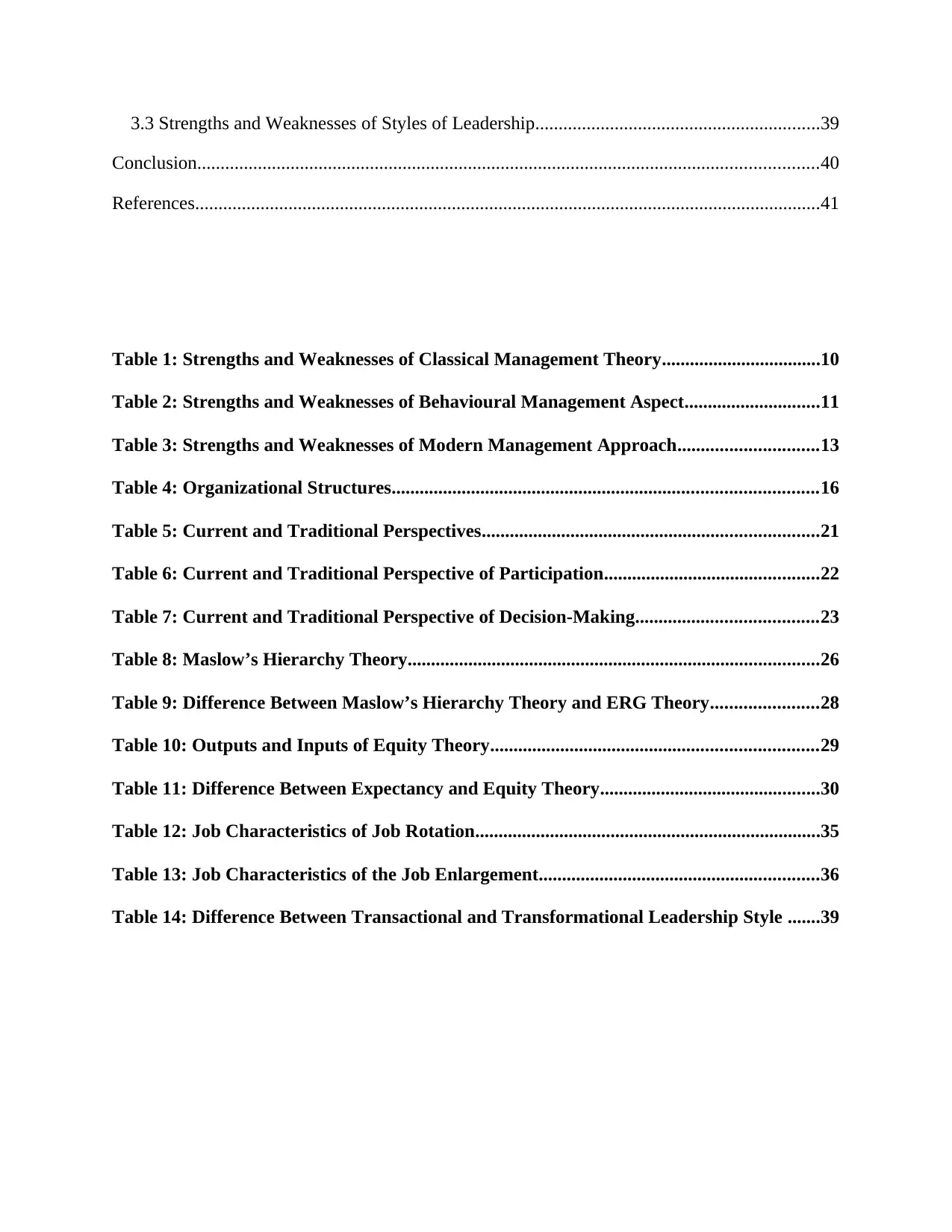
3.3 Strengths and Weaknesses of Styles of Leadership.............................................................39
Conclusion.....................................................................................................................................40
References......................................................................................................................................41
Table 1: Strengths and Weaknesses of Classical Management Theory..................................10
Table 2: Strengths and Weaknesses of Behavioural Management Aspect.............................11
Table 3: Strengths and Weaknesses of Modern Management Approach..............................13
Table 4: Organizational Structures...........................................................................................16
Table 5: Current and Traditional Perspectives........................................................................21
Table 6: Current and Traditional Perspective of Participation..............................................22
Table 7: Current and Traditional Perspective of Decision-Making.......................................23
Table 8: Maslow’s Hierarchy Theory........................................................................................26
Table 9: Difference Between Maslow’s Hierarchy Theory and ERG Theory.......................28
Table 10: Outputs and Inputs of Equity Theory......................................................................29
Table 11: Difference Between Expectancy and Equity Theory...............................................30
Table 12: Job Characteristics of Job Rotation..........................................................................35
Table 13: Job Characteristics of the Job Enlargement............................................................36
Table 14: Difference Between Transactional and Transformational Leadership Style .......39
Conclusion.....................................................................................................................................40
References......................................................................................................................................41
Table 1: Strengths and Weaknesses of Classical Management Theory..................................10
Table 2: Strengths and Weaknesses of Behavioural Management Aspect.............................11
Table 3: Strengths and Weaknesses of Modern Management Approach..............................13
Table 4: Organizational Structures...........................................................................................16
Table 5: Current and Traditional Perspectives........................................................................21
Table 6: Current and Traditional Perspective of Participation..............................................22
Table 7: Current and Traditional Perspective of Decision-Making.......................................23
Table 8: Maslow’s Hierarchy Theory........................................................................................26
Table 9: Difference Between Maslow’s Hierarchy Theory and ERG Theory.......................28
Table 10: Outputs and Inputs of Equity Theory......................................................................29
Table 11: Difference Between Expectancy and Equity Theory...............................................30
Table 12: Job Characteristics of Job Rotation..........................................................................35
Table 13: Job Characteristics of the Job Enlargement............................................................36
Table 14: Difference Between Transactional and Transformational Leadership Style .......39
Paraphrase This Document
Need a fresh take? Get an instant paraphrase of this document with our AI Paraphraser
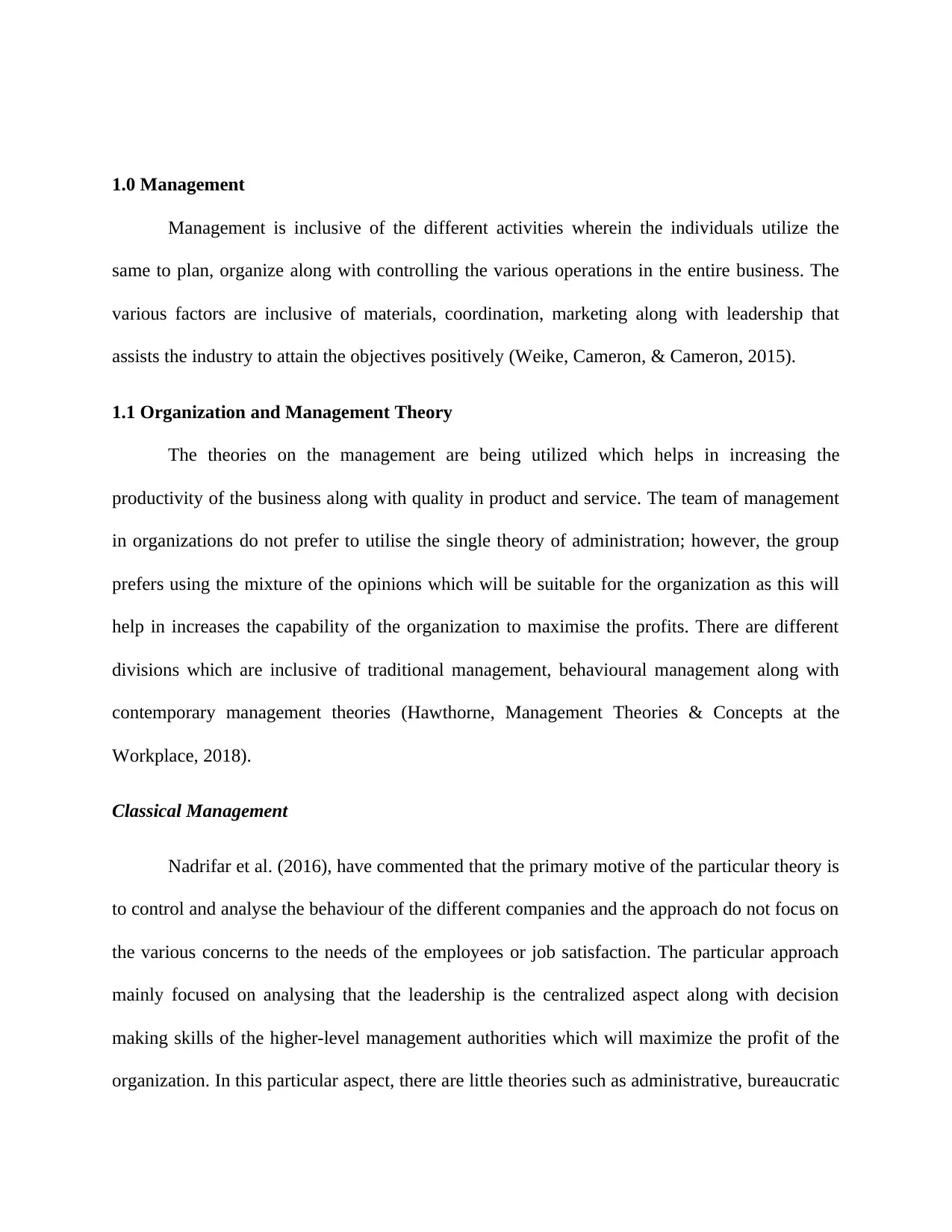
1.0 Management
Management is inclusive of the different activities wherein the individuals utilize the
same to plan, organize along with controlling the various operations in the entire business. The
various factors are inclusive of materials, coordination, marketing along with leadership that
assists the industry to attain the objectives positively (Weike, Cameron, & Cameron, 2015).
1.1 Organization and Management Theory
The theories on the management are being utilized which helps in increasing the
productivity of the business along with quality in product and service. The team of management
in organizations do not prefer to utilise the single theory of administration; however, the group
prefers using the mixture of the opinions which will be suitable for the organization as this will
help in increases the capability of the organization to maximise the profits. There are different
divisions which are inclusive of traditional management, behavioural management along with
contemporary management theories (Hawthorne, Management Theories & Concepts at the
Workplace, 2018).
Classical Management
Nadrifar et al. (2016), have commented that the primary motive of the particular theory is
to control and analyse the behaviour of the different companies and the approach do not focus on
the various concerns to the needs of the employees or job satisfaction. The particular approach
mainly focused on analysing that the leadership is the centralized aspect along with decision
making skills of the higher-level management authorities which will maximize the profit of the
organization. In this particular aspect, there are little theories such as administrative, bureaucratic
Management is inclusive of the different activities wherein the individuals utilize the
same to plan, organize along with controlling the various operations in the entire business. The
various factors are inclusive of materials, coordination, marketing along with leadership that
assists the industry to attain the objectives positively (Weike, Cameron, & Cameron, 2015).
1.1 Organization and Management Theory
The theories on the management are being utilized which helps in increasing the
productivity of the business along with quality in product and service. The team of management
in organizations do not prefer to utilise the single theory of administration; however, the group
prefers using the mixture of the opinions which will be suitable for the organization as this will
help in increases the capability of the organization to maximise the profits. There are different
divisions which are inclusive of traditional management, behavioural management along with
contemporary management theories (Hawthorne, Management Theories & Concepts at the
Workplace, 2018).
Classical Management
Nadrifar et al. (2016), have commented that the primary motive of the particular theory is
to control and analyse the behaviour of the different companies and the approach do not focus on
the various concerns to the needs of the employees or job satisfaction. The particular approach
mainly focused on analysing that the leadership is the centralized aspect along with decision
making skills of the higher-level management authorities which will maximize the profit of the
organization. In this particular aspect, there are little theories such as administrative, bureaucratic
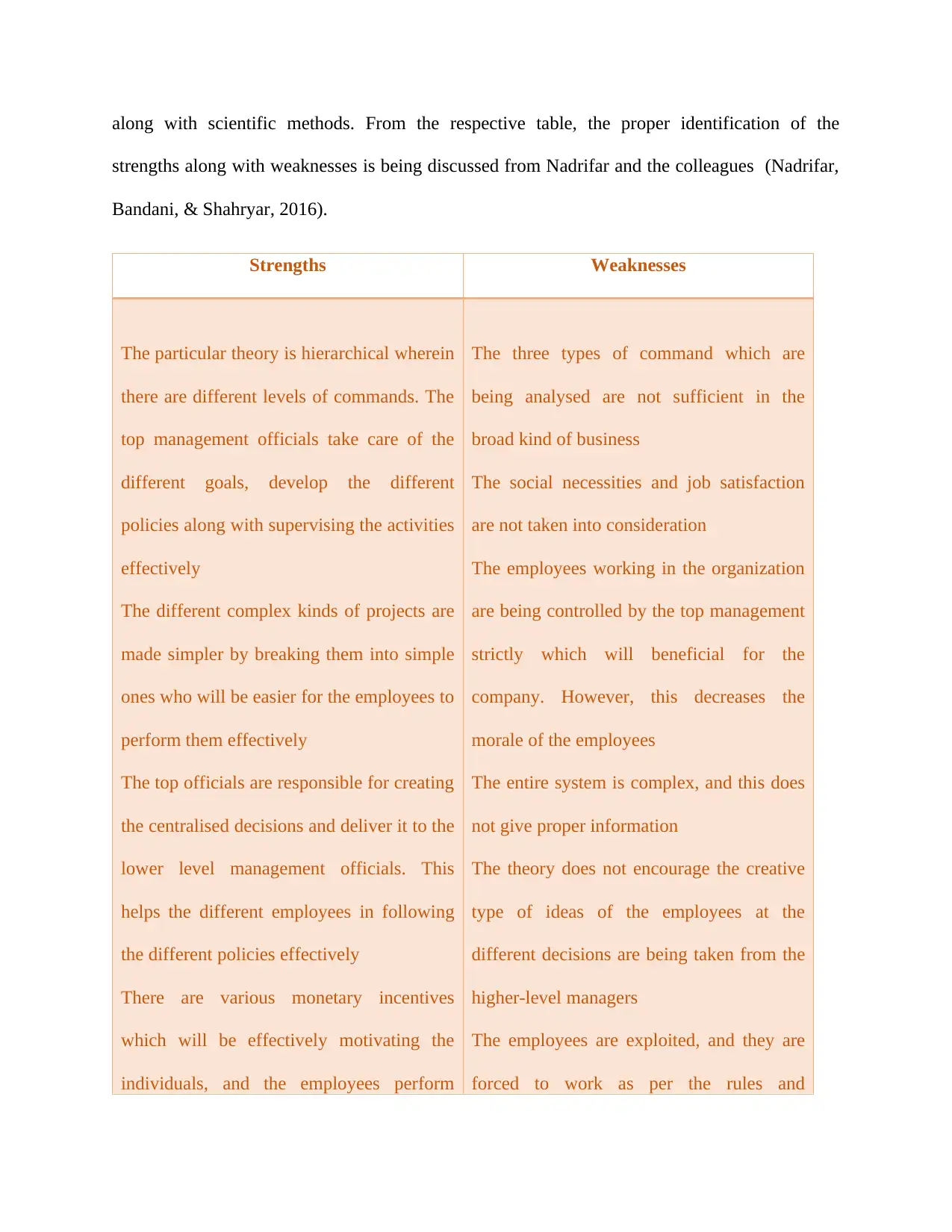
along with scientific methods. From the respective table, the proper identification of the
strengths along with weaknesses is being discussed from Nadrifar and the colleagues (Nadrifar,
Bandani, & Shahryar, 2016).
Strengths Weaknesses
The particular theory is hierarchical wherein
there are different levels of commands. The
top management officials take care of the
different goals, develop the different
policies along with supervising the activities
effectively
The different complex kinds of projects are
made simpler by breaking them into simple
ones who will be easier for the employees to
perform them effectively
The top officials are responsible for creating
the centralised decisions and deliver it to the
lower level management officials. This
helps the different employees in following
the different policies effectively
There are various monetary incentives
which will be effectively motivating the
individuals, and the employees perform
The three types of command which are
being analysed are not sufficient in the
broad kind of business
The social necessities and job satisfaction
are not taken into consideration
The employees working in the organization
are being controlled by the top management
strictly which will beneficial for the
company. However, this decreases the
morale of the employees
The entire system is complex, and this does
not give proper information
The theory does not encourage the creative
type of ideas of the employees at the
different decisions are being taken from the
higher-level managers
The employees are exploited, and they are
forced to work as per the rules and
strengths along with weaknesses is being discussed from Nadrifar and the colleagues (Nadrifar,
Bandani, & Shahryar, 2016).
Strengths Weaknesses
The particular theory is hierarchical wherein
there are different levels of commands. The
top management officials take care of the
different goals, develop the different
policies along with supervising the activities
effectively
The different complex kinds of projects are
made simpler by breaking them into simple
ones who will be easier for the employees to
perform them effectively
The top officials are responsible for creating
the centralised decisions and deliver it to the
lower level management officials. This
helps the different employees in following
the different policies effectively
There are various monetary incentives
which will be effectively motivating the
individuals, and the employees perform
The three types of command which are
being analysed are not sufficient in the
broad kind of business
The social necessities and job satisfaction
are not taken into consideration
The employees working in the organization
are being controlled by the top management
strictly which will beneficial for the
company. However, this decreases the
morale of the employees
The entire system is complex, and this does
not give proper information
The theory does not encourage the creative
type of ideas of the employees at the
different decisions are being taken from the
higher-level managers
The employees are exploited, and they are
forced to work as per the rules and
⊘ This is a preview!⊘
Do you want full access?
Subscribe today to unlock all pages.

Trusted by 1+ million students worldwide
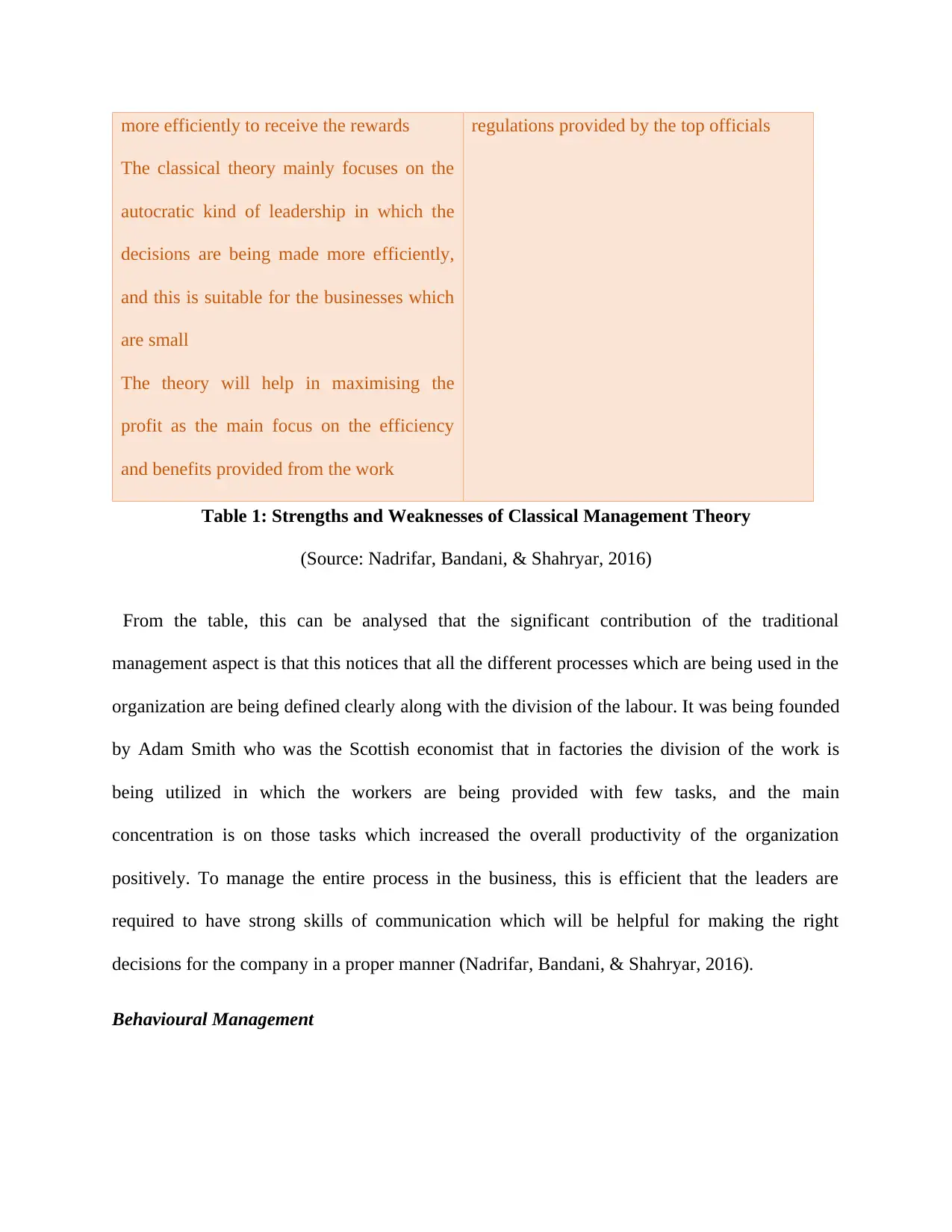
more efficiently to receive the rewards
The classical theory mainly focuses on the
autocratic kind of leadership in which the
decisions are being made more efficiently,
and this is suitable for the businesses which
are small
The theory will help in maximising the
profit as the main focus on the efficiency
and benefits provided from the work
regulations provided by the top officials
Table 1: Strengths and Weaknesses of Classical Management Theory
(Source: Nadrifar, Bandani, & Shahryar, 2016)
From the table, this can be analysed that the significant contribution of the traditional
management aspect is that this notices that all the different processes which are being used in the
organization are being defined clearly along with the division of the labour. It was being founded
by Adam Smith who was the Scottish economist that in factories the division of the work is
being utilized in which the workers are being provided with few tasks, and the main
concentration is on those tasks which increased the overall productivity of the organization
positively. To manage the entire process in the business, this is efficient that the leaders are
required to have strong skills of communication which will be helpful for making the right
decisions for the company in a proper manner (Nadrifar, Bandani, & Shahryar, 2016).
Behavioural Management
The classical theory mainly focuses on the
autocratic kind of leadership in which the
decisions are being made more efficiently,
and this is suitable for the businesses which
are small
The theory will help in maximising the
profit as the main focus on the efficiency
and benefits provided from the work
regulations provided by the top officials
Table 1: Strengths and Weaknesses of Classical Management Theory
(Source: Nadrifar, Bandani, & Shahryar, 2016)
From the table, this can be analysed that the significant contribution of the traditional
management aspect is that this notices that all the different processes which are being used in the
organization are being defined clearly along with the division of the labour. It was being founded
by Adam Smith who was the Scottish economist that in factories the division of the work is
being utilized in which the workers are being provided with few tasks, and the main
concentration is on those tasks which increased the overall productivity of the organization
positively. To manage the entire process in the business, this is efficient that the leaders are
required to have strong skills of communication which will be helpful for making the right
decisions for the company in a proper manner (Nadrifar, Bandani, & Shahryar, 2016).
Behavioural Management
Paraphrase This Document
Need a fresh take? Get an instant paraphrase of this document with our AI Paraphraser
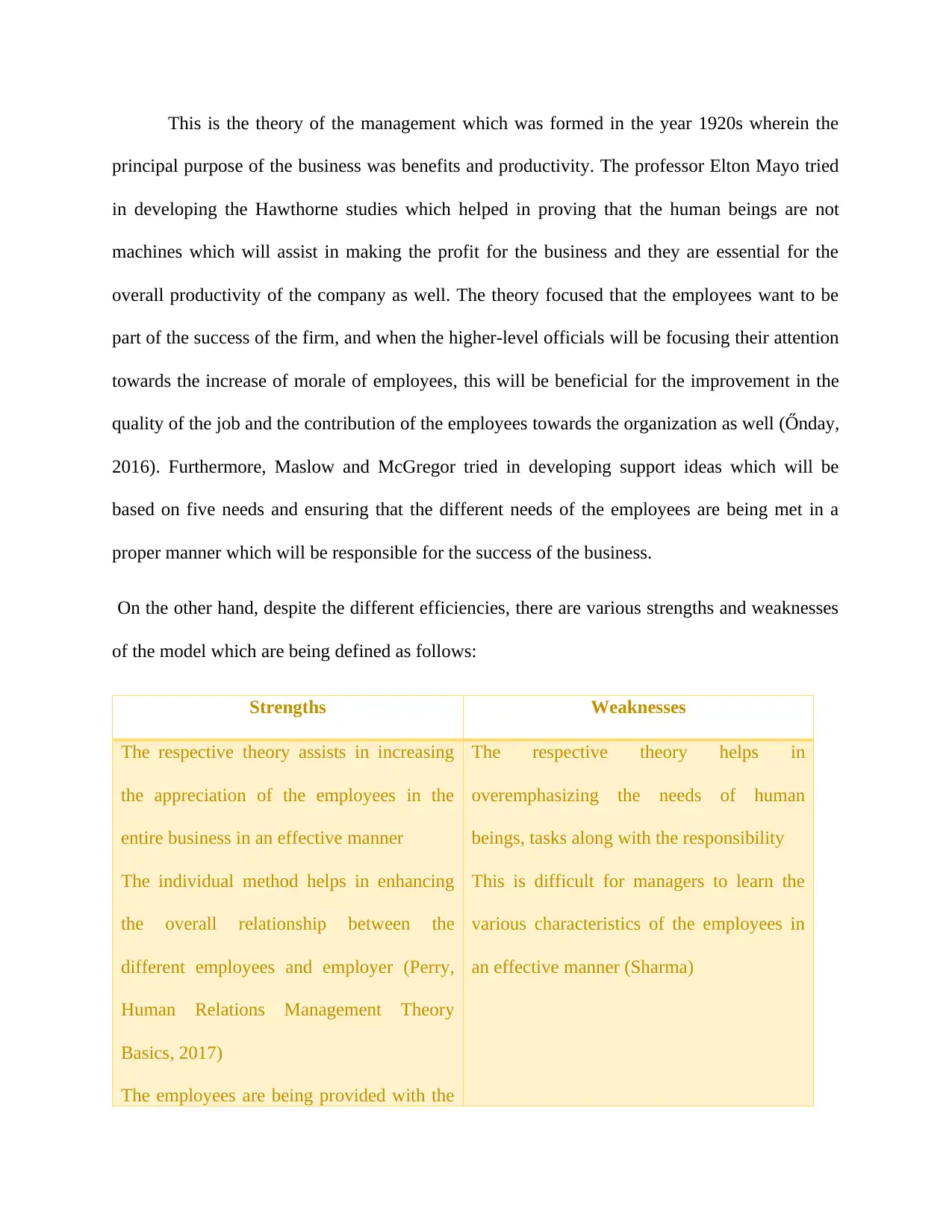
This is the theory of the management which was formed in the year 1920s wherein the
principal purpose of the business was benefits and productivity. The professor Elton Mayo tried
in developing the Hawthorne studies which helped in proving that the human beings are not
machines which will assist in making the profit for the business and they are essential for the
overall productivity of the company as well. The theory focused that the employees want to be
part of the success of the firm, and when the higher-level officials will be focusing their attention
towards the increase of morale of employees, this will be beneficial for the improvement in the
quality of the job and the contribution of the employees towards the organization as well (Őnday,
2016). Furthermore, Maslow and McGregor tried in developing support ideas which will be
based on five needs and ensuring that the different needs of the employees are being met in a
proper manner which will be responsible for the success of the business.
On the other hand, despite the different efficiencies, there are various strengths and weaknesses
of the model which are being defined as follows:
Strengths Weaknesses
The respective theory assists in increasing
the appreciation of the employees in the
entire business in an effective manner
The individual method helps in enhancing
the overall relationship between the
different employees and employer (Perry,
Human Relations Management Theory
Basics, 2017)
The employees are being provided with the
The respective theory helps in
overemphasizing the needs of human
beings, tasks along with the responsibility
This is difficult for managers to learn the
various characteristics of the employees in
an effective manner (Sharma)
principal purpose of the business was benefits and productivity. The professor Elton Mayo tried
in developing the Hawthorne studies which helped in proving that the human beings are not
machines which will assist in making the profit for the business and they are essential for the
overall productivity of the company as well. The theory focused that the employees want to be
part of the success of the firm, and when the higher-level officials will be focusing their attention
towards the increase of morale of employees, this will be beneficial for the improvement in the
quality of the job and the contribution of the employees towards the organization as well (Őnday,
2016). Furthermore, Maslow and McGregor tried in developing support ideas which will be
based on five needs and ensuring that the different needs of the employees are being met in a
proper manner which will be responsible for the success of the business.
On the other hand, despite the different efficiencies, there are various strengths and weaknesses
of the model which are being defined as follows:
Strengths Weaknesses
The respective theory assists in increasing
the appreciation of the employees in the
entire business in an effective manner
The individual method helps in enhancing
the overall relationship between the
different employees and employer (Perry,
Human Relations Management Theory
Basics, 2017)
The employees are being provided with the
The respective theory helps in
overemphasizing the needs of human
beings, tasks along with the responsibility
This is difficult for managers to learn the
various characteristics of the employees in
an effective manner (Sharma)
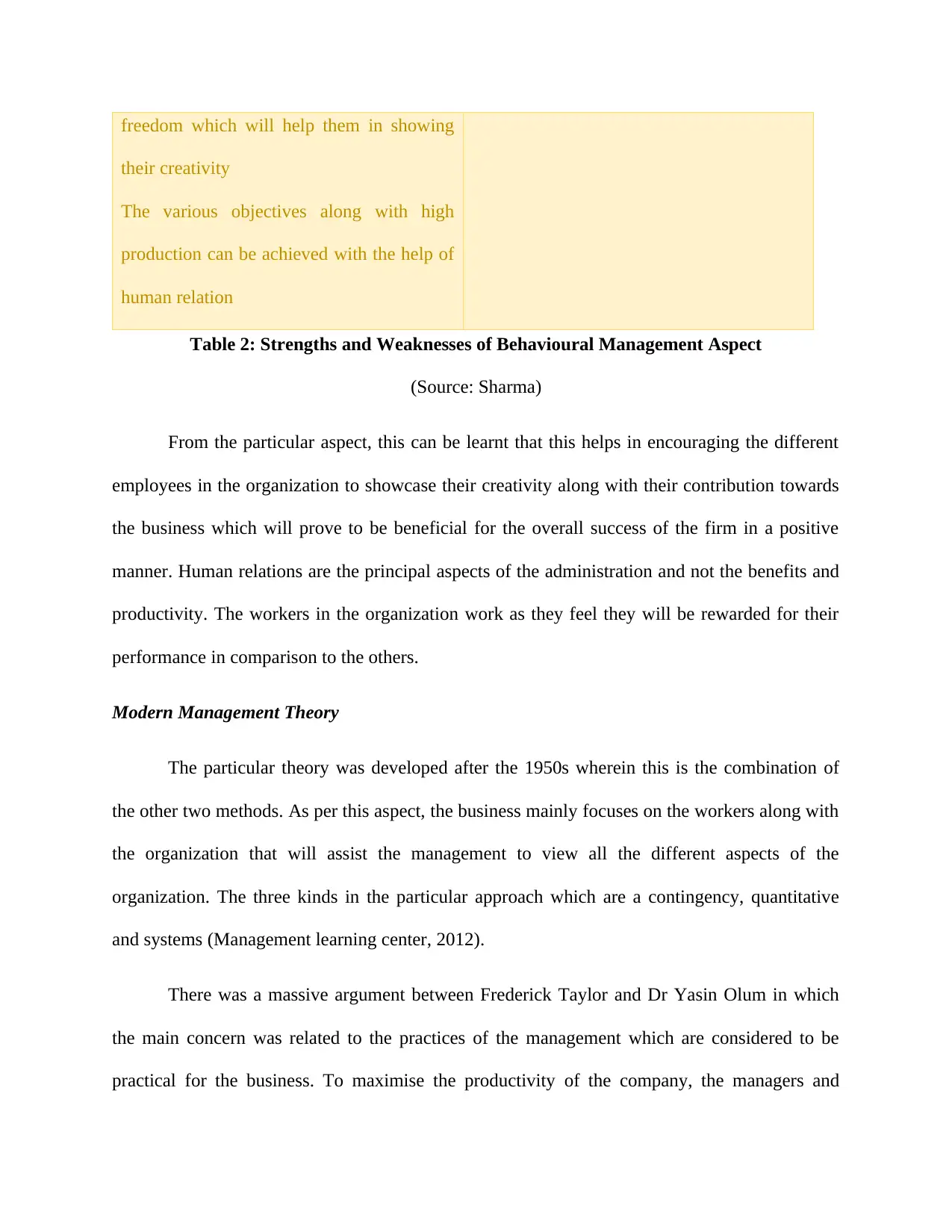
freedom which will help them in showing
their creativity
The various objectives along with high
production can be achieved with the help of
human relation
Table 2: Strengths and Weaknesses of Behavioural Management Aspect
(Source: Sharma)
From the particular aspect, this can be learnt that this helps in encouraging the different
employees in the organization to showcase their creativity along with their contribution towards
the business which will prove to be beneficial for the overall success of the firm in a positive
manner. Human relations are the principal aspects of the administration and not the benefits and
productivity. The workers in the organization work as they feel they will be rewarded for their
performance in comparison to the others.
Modern Management Theory
The particular theory was developed after the 1950s wherein this is the combination of
the other two methods. As per this aspect, the business mainly focuses on the workers along with
the organization that will assist the management to view all the different aspects of the
organization. The three kinds in the particular approach which are a contingency, quantitative
and systems (Management learning center, 2012).
There was a massive argument between Frederick Taylor and Dr Yasin Olum in which
the main concern was related to the practices of the management which are considered to be
practical for the business. To maximise the productivity of the company, the managers and
their creativity
The various objectives along with high
production can be achieved with the help of
human relation
Table 2: Strengths and Weaknesses of Behavioural Management Aspect
(Source: Sharma)
From the particular aspect, this can be learnt that this helps in encouraging the different
employees in the organization to showcase their creativity along with their contribution towards
the business which will prove to be beneficial for the overall success of the firm in a positive
manner. Human relations are the principal aspects of the administration and not the benefits and
productivity. The workers in the organization work as they feel they will be rewarded for their
performance in comparison to the others.
Modern Management Theory
The particular theory was developed after the 1950s wherein this is the combination of
the other two methods. As per this aspect, the business mainly focuses on the workers along with
the organization that will assist the management to view all the different aspects of the
organization. The three kinds in the particular approach which are a contingency, quantitative
and systems (Management learning center, 2012).
There was a massive argument between Frederick Taylor and Dr Yasin Olum in which
the main concern was related to the practices of the management which are considered to be
practical for the business. To maximise the productivity of the company, the managers and
⊘ This is a preview!⊘
Do you want full access?
Subscribe today to unlock all pages.

Trusted by 1+ million students worldwide
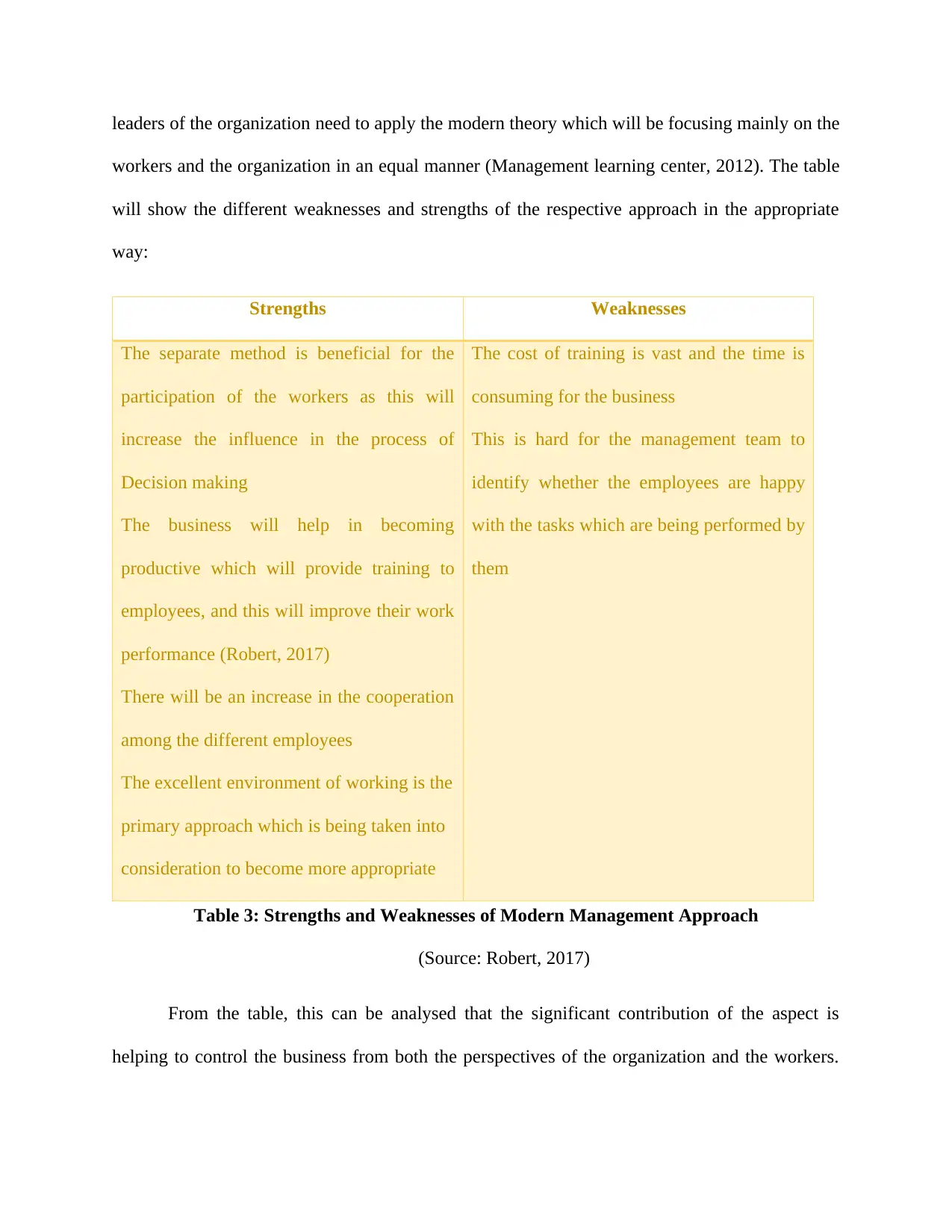
leaders of the organization need to apply the modern theory which will be focusing mainly on the
workers and the organization in an equal manner (Management learning center, 2012). The table
will show the different weaknesses and strengths of the respective approach in the appropriate
way:
Strengths Weaknesses
The separate method is beneficial for the
participation of the workers as this will
increase the influence in the process of
Decision making
The business will help in becoming
productive which will provide training to
employees, and this will improve their work
performance (Robert, 2017)
There will be an increase in the cooperation
among the different employees
The excellent environment of working is the
primary approach which is being taken into
consideration to become more appropriate
The cost of training is vast and the time is
consuming for the business
This is hard for the management team to
identify whether the employees are happy
with the tasks which are being performed by
them
Table 3: Strengths and Weaknesses of Modern Management Approach
(Source: Robert, 2017)
From the table, this can be analysed that the significant contribution of the aspect is
helping to control the business from both the perspectives of the organization and the workers.
workers and the organization in an equal manner (Management learning center, 2012). The table
will show the different weaknesses and strengths of the respective approach in the appropriate
way:
Strengths Weaknesses
The separate method is beneficial for the
participation of the workers as this will
increase the influence in the process of
Decision making
The business will help in becoming
productive which will provide training to
employees, and this will improve their work
performance (Robert, 2017)
There will be an increase in the cooperation
among the different employees
The excellent environment of working is the
primary approach which is being taken into
consideration to become more appropriate
The cost of training is vast and the time is
consuming for the business
This is hard for the management team to
identify whether the employees are happy
with the tasks which are being performed by
them
Table 3: Strengths and Weaknesses of Modern Management Approach
(Source: Robert, 2017)
From the table, this can be analysed that the significant contribution of the aspect is
helping to control the business from both the perspectives of the organization and the workers.
Paraphrase This Document
Need a fresh take? Get an instant paraphrase of this document with our AI Paraphraser
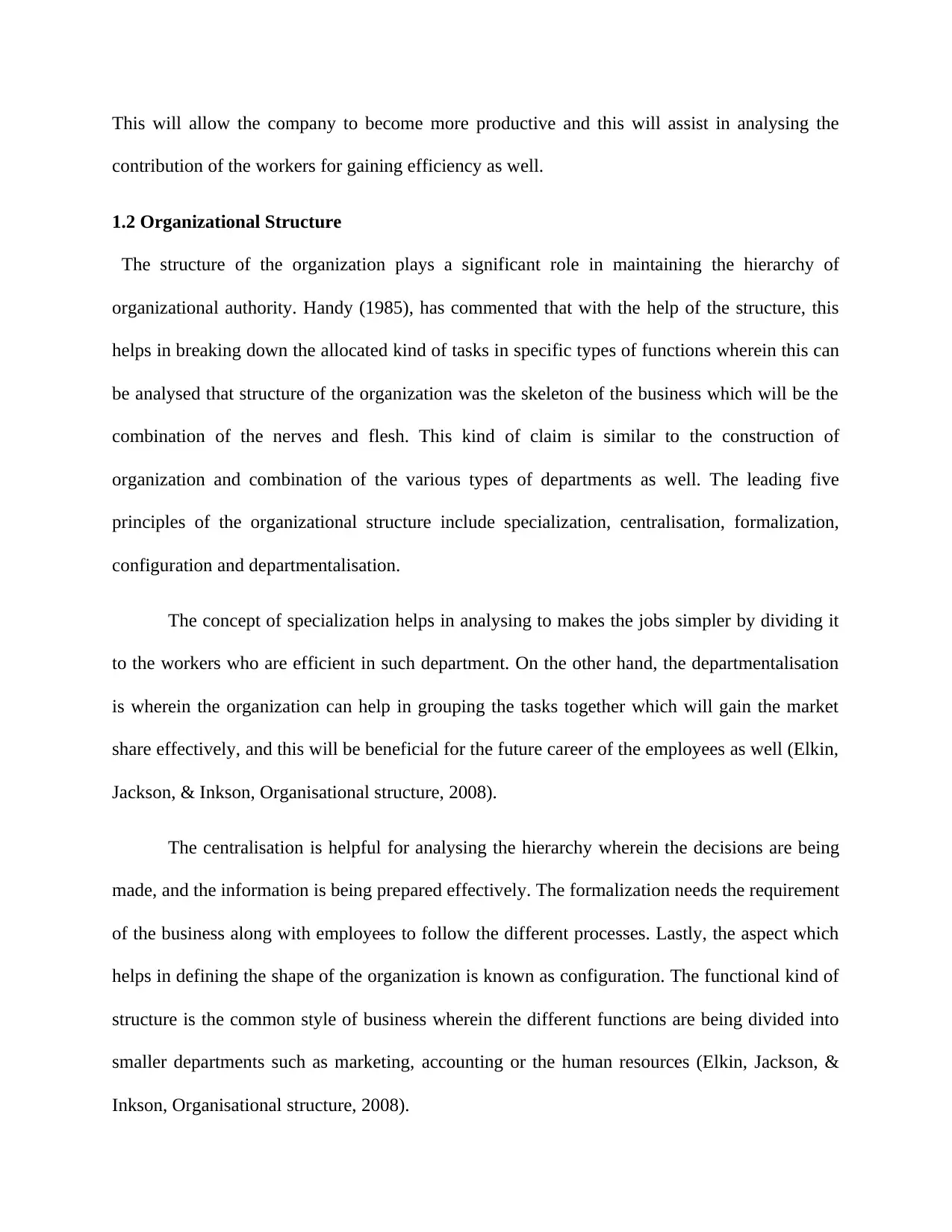
This will allow the company to become more productive and this will assist in analysing the
contribution of the workers for gaining efficiency as well.
1.2 Organizational Structure
The structure of the organization plays a significant role in maintaining the hierarchy of
organizational authority. Handy (1985), has commented that with the help of the structure, this
helps in breaking down the allocated kind of tasks in specific types of functions wherein this can
be analysed that structure of the organization was the skeleton of the business which will be the
combination of the nerves and flesh. This kind of claim is similar to the construction of
organization and combination of the various types of departments as well. The leading five
principles of the organizational structure include specialization, centralisation, formalization,
configuration and departmentalisation.
The concept of specialization helps in analysing to makes the jobs simpler by dividing it
to the workers who are efficient in such department. On the other hand, the departmentalisation
is wherein the organization can help in grouping the tasks together which will gain the market
share effectively, and this will be beneficial for the future career of the employees as well (Elkin,
Jackson, & Inkson, Organisational structure, 2008).
The centralisation is helpful for analysing the hierarchy wherein the decisions are being
made, and the information is being prepared effectively. The formalization needs the requirement
of the business along with employees to follow the different processes. Lastly, the aspect which
helps in defining the shape of the organization is known as configuration. The functional kind of
structure is the common style of business wherein the different functions are being divided into
smaller departments such as marketing, accounting or the human resources (Elkin, Jackson, &
Inkson, Organisational structure, 2008).
contribution of the workers for gaining efficiency as well.
1.2 Organizational Structure
The structure of the organization plays a significant role in maintaining the hierarchy of
organizational authority. Handy (1985), has commented that with the help of the structure, this
helps in breaking down the allocated kind of tasks in specific types of functions wherein this can
be analysed that structure of the organization was the skeleton of the business which will be the
combination of the nerves and flesh. This kind of claim is similar to the construction of
organization and combination of the various types of departments as well. The leading five
principles of the organizational structure include specialization, centralisation, formalization,
configuration and departmentalisation.
The concept of specialization helps in analysing to makes the jobs simpler by dividing it
to the workers who are efficient in such department. On the other hand, the departmentalisation
is wherein the organization can help in grouping the tasks together which will gain the market
share effectively, and this will be beneficial for the future career of the employees as well (Elkin,
Jackson, & Inkson, Organisational structure, 2008).
The centralisation is helpful for analysing the hierarchy wherein the decisions are being
made, and the information is being prepared effectively. The formalization needs the requirement
of the business along with employees to follow the different processes. Lastly, the aspect which
helps in defining the shape of the organization is known as configuration. The functional kind of
structure is the common style of business wherein the different functions are being divided into
smaller departments such as marketing, accounting or the human resources (Elkin, Jackson, &
Inkson, Organisational structure, 2008).
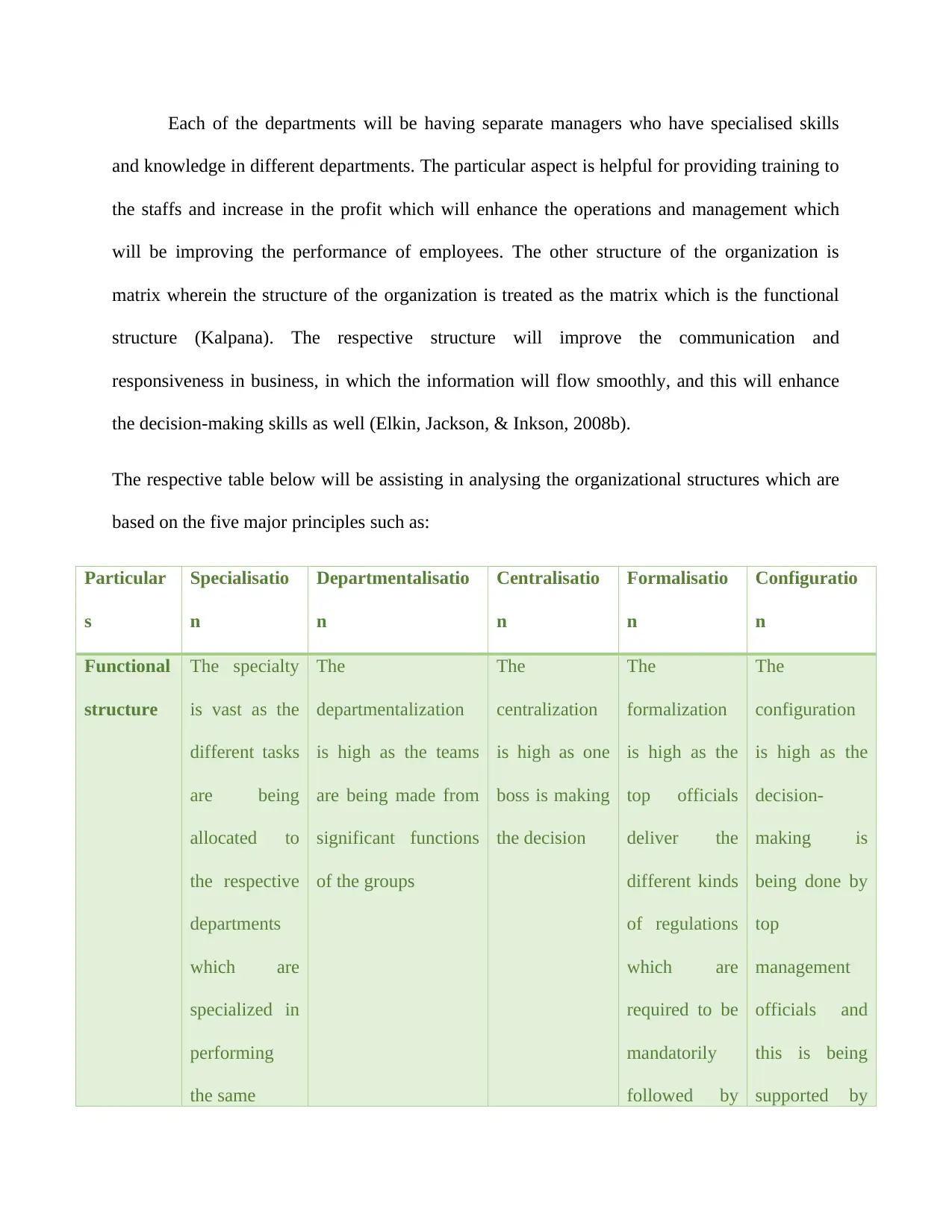
Each of the departments will be having separate managers who have specialised skills
and knowledge in different departments. The particular aspect is helpful for providing training to
the staffs and increase in the profit which will enhance the operations and management which
will be improving the performance of employees. The other structure of the organization is
matrix wherein the structure of the organization is treated as the matrix which is the functional
structure (Kalpana). The respective structure will improve the communication and
responsiveness in business, in which the information will flow smoothly, and this will enhance
the decision-making skills as well (Elkin, Jackson, & Inkson, 2008b).
The respective table below will be assisting in analysing the organizational structures which are
based on the five major principles such as:
Particular
s
Specialisatio
n
Departmentalisatio
n
Centralisatio
n
Formalisatio
n
Configuratio
n
Functional
structure
The specialty
is vast as the
different tasks
are being
allocated to
the respective
departments
which are
specialized in
performing
the same
The
departmentalization
is high as the teams
are being made from
significant functions
of the groups
The
centralization
is high as one
boss is making
the decision
The
formalization
is high as the
top officials
deliver the
different kinds
of regulations
which are
required to be
mandatorily
followed by
The
configuration
is high as the
decision-
making is
being done by
top
management
officials and
this is being
supported by
and knowledge in different departments. The particular aspect is helpful for providing training to
the staffs and increase in the profit which will enhance the operations and management which
will be improving the performance of employees. The other structure of the organization is
matrix wherein the structure of the organization is treated as the matrix which is the functional
structure (Kalpana). The respective structure will improve the communication and
responsiveness in business, in which the information will flow smoothly, and this will enhance
the decision-making skills as well (Elkin, Jackson, & Inkson, 2008b).
The respective table below will be assisting in analysing the organizational structures which are
based on the five major principles such as:
Particular
s
Specialisatio
n
Departmentalisatio
n
Centralisatio
n
Formalisatio
n
Configuratio
n
Functional
structure
The specialty
is vast as the
different tasks
are being
allocated to
the respective
departments
which are
specialized in
performing
the same
The
departmentalization
is high as the teams
are being made from
significant functions
of the groups
The
centralization
is high as one
boss is making
the decision
The
formalization
is high as the
top officials
deliver the
different kinds
of regulations
which are
required to be
mandatorily
followed by
The
configuration
is high as the
decision-
making is
being done by
top
management
officials and
this is being
supported by
⊘ This is a preview!⊘
Do you want full access?
Subscribe today to unlock all pages.

Trusted by 1+ million students worldwide
1 out of 48
Related Documents
Your All-in-One AI-Powered Toolkit for Academic Success.
+13062052269
info@desklib.com
Available 24*7 on WhatsApp / Email
![[object Object]](/_next/static/media/star-bottom.7253800d.svg)
Unlock your academic potential
Copyright © 2020–2025 A2Z Services. All Rights Reserved. Developed and managed by ZUCOL.



